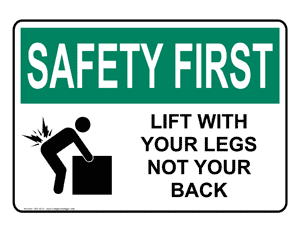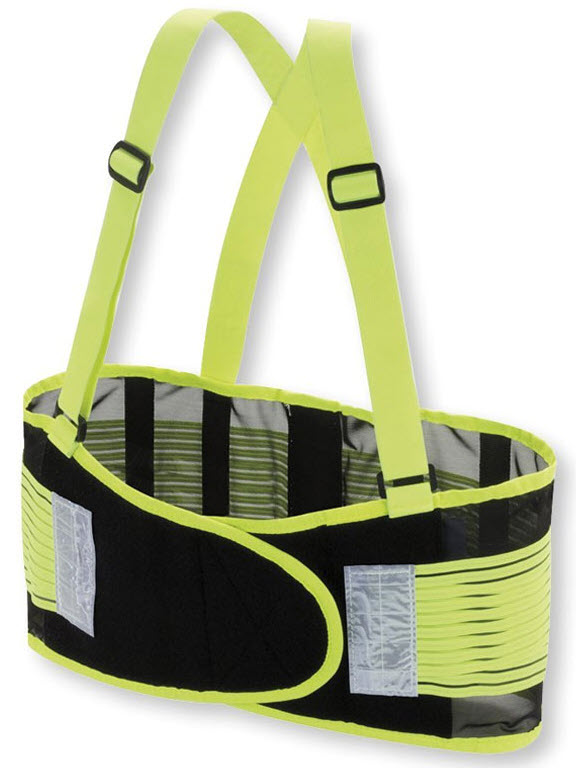Watch Your Back
Avoid Injuries During Manual Lifting

Back injuries account for a significant amount of human suffering, loss of productivity, and economic burden on compensation systems. Back disorders are one of the leading causes of disability for people in their working years. The frequency and economic impact of back injuries and disorders on the work force are expected to increase over the next several decades as the average age of the work force increases and medical costs go up.
The federal Bureau of Labor Statistics says that one million workers suffer back injuries every year. Back injuries heal slowly and could prevent you from working and enjoying life for a long time.
MANUAL SLAB HANDLING
A major potential hazard in this industry involves working with stone slabs in the shop or on the residential or commercial jobsite. Avoid serious injury by following these precautions and paying strict attention to the job at hand:
- Avoid lifting where possible and practical by pushing, pulling, rolling or sliding slabs to be moved.
- Use mechanical aids (slab dollies, suction lifts, lifting clamps, etc.) or request help from coworkers.
- You should not attempt to manually lift items weighing over 75 pounds.
- Lift only loads that can be safely handled. Consider the size, weight and shape of the slab.
- Never lift or carry a stone slab in the flat (horizontal) position. Always lift the slab on end in the vertical position. Lifting the slab flat can cause the slab to break, causing injury.
- When unloading slabs, never let a coworker support a slab alone.
- Never jump off a dock onto a truck containing slabs. This could cause the slabs to shift or tip over.
- Always stand at the end of the slab.
- Failure to follow these safety procedures properly or to pay attention to workplace hazards can result in serious injury to you and your coworkers.
CalOSHA Report
Employee #1 was working as a sawyer. He and two other employees were transferring a granite slab weighing approximately 750 lbs onto the saw table. Employee #1 positioned himself on one end; the other two lifted the other end of the slab. When the other employees lifted their end, the opposite end of the slab shifted towards Employee #1. He experienced immediate back pain when he tried to compensate for the sudden increase in weight.
Employee #1 was hospitalized for six days for his back injury. Employer cited for not having an Accident Prevention Program in place.
This case is representative of injuries caused by improper work practices. No special emphasis or priority is implied nor is the case necessarily a recent occurrence. The legal aspects of the incident have been resolved, and the case is now closed.

PROPER LIFTING TECHNIQUE
- Warm up before lifting. Stretch with side and back bends.
- The technique to proper lifting is to bend your knees, not your back, and let the more powerful leg muscles do most of the work.
- Establish good footing. Keep the load close to your body. Bend at the knees as you grasp the slab. Get a full handgrip; keep your body erect and your spine in an upright (vertical) position.
- Lift smoothly, straightening the legs (avoid jerky lifts). Reverse the procedure to set the slab down.
- Avoid twisting your body when lifting. When turning, shift the position of your feet rather than twisting your body at the waist.
BACK BELTS
A great deal of controversy surrounds the efficacy of back belts in preventing back injuries. Several large companies’ research and experience has shown positive results, while NIOSH and other researchers’ efforts have turned up inconclusive results.
When properly used, back belts probably do no harm, but misunderstanding their function and capabilities may create unrealistic expectations about their benefits, and the capabilities of workers wearing them.
Like any tool, they must be used properly, and workers new to any tool must be trained in proper use. You cannot expect to just hand out back belts and expect back injuries to go away.
Likewise, back belts do not increase the lifting or materials handling capacity of an individual.

BACK INJURY AND BACK PAIN
Back symptoms are among the top ten reasons for medical visits, according to the federal Center for Disease Control (CDC). For 5% to 10% of patients, the back pain becomes chronic.
In 2001, the BLS reported 372,683 back-injury cases involving days away from work. Most involved workers aged 25–54 (79%), male (64%), and white, non-Hispanic (70%).
Two occupational groups accounted for more than 54% of cases: operators, fabricators and laborers (38%); and precision production, craft and repair (17%).
Data from scientific studies of primary and secondary interventions indicate that low back pain can be reduced by:
- Engineering controls (e.g., ergonomic workplace redesign).
- Administrative controls (specifically, adjusting work schedules and workloads).
- Programs designed to modify individual factors, such as employee exercise.
- Combinations of these approaches.
Remember: Safety is the responsibility of management and employees!◙
The information herein is provided by the Natural Stone Institute as a general summary for use in job site toolbox talks and is provided to augment and not substitute for or replace required training under any applicable local, state or federal workplace statute, law or regulation. It is the user’s responsibility to ensure this content is consistent with job site requirements and applicable statutes, laws or regulations prior to use and make any required additions or changes.

